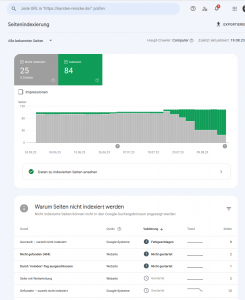It’s a while ago, that I wrote about SEO. That should not be a big deal, I thought at that time. In its templates, bootScore thankfully uses semantic HTML tags by default. Thus, it should be sufficient to submit one’s own sitemap to Google & Co. Enriching the pages themselves with additional keywords should be superfluous. A good primary content would be enough. No need for a second text behind the actual one. That’s the way, I thought. Moreover, I saw no reason to talk about internal linking. Rarely has Google so embarrassingly proven me wrong:
Solution
- Replace all schematic slugs with talking ones.
- Link every post and page to all other internal, related posts or pages.
- Install YoastSEO.
- Implement so many improvements suggested by YoastSEO that its traffic lights turn green.
- For every single page and post, explicitly ask Google via the Google Search Console to index that text.
Background
What has happened, that I changed my mind? After submitting my sitemap sometime in April, Google had indexed only 6 of my 109 pages over 3 months. It did not grumble about the quality. It simply announced that it had found 81 pages or posts and had crawled 17, but had not indexed any of them. Google did not consider my texts worthy of indexing. Despite my interesting topic, ‘bootScore’. And in spite of the articles being so relevant, they could inspire the project ‘bootScore’. In this situation, trying to improve my ranking was nonsense: what’s not indexed, is not found at all.
It took me a while to understand what had happened. And it took me even more time to fix that:
While migrating to bootScore, I wanted to condense my site. It should become more reader-friendly with less redundancy. Fewer bells and whistles. That’s why I mapped my thematic clusters onto categories and tags and properly assigned my texts to them. I wanted to take advantage of what bootScore brings to the table on its own. On each page, our readers can call the related posts by clicking on the assigned keywords. So why should I additionally link a post to related ones manually? Why should I hook individual pages or posts into my menu? A clever guiding system of categories without any additional inner linking should be enough.
But that’s exactly what Google sees differently! Pages that are not linked to other pages on the same site are not important — apparently, even in the eyes of the author. Otherwise, she would want to lead her readers there. So why should Google index them? My textbooks((Pars pro toto: cf. Czysch, Stephan: SEO mit Google Search Console, 2. Ed., Heidelberg 2017, pp. 168ff)) had always pointed out that! It was my fault to ignore that.
Just, as my fault for grouping my posts with nonspeaking ‘slugs’: If I — for example — used a cluster ‘image’, I thought I could name my posts ‘image‑a’ , … ‘image‑i’. So, I had the same page names on the German and the English sites. Also, a bad idea that causes Google to take the posts as unimportant.((pars pro toto: cf. Dziki, Julian: Suchmaschinenoptomierung für dummies, 2. Ed., Weinheim 2021, p. 62)
After having understood these side effects, I reworked everything. I replaced the symbolic page names with speaking ones. I installed YoastSeo and implemented so many of its measures concerning the topics ‘SEO’ and ‘readability’ that the respective traffic lights switched from red to green. Or at least to yellow. All in all a very time-consuming work.
Nevertheless, there was still no inner linking with it. That’s why I wrote a summary for each of my thematic clusters and linked its words to the intended ‘siblings’ of posts and pages. Moreover, because — in the Future — I would have to update these summaries often, I reduced my typing work by implementing these summaries as ShortCodes. So, a simple string at the end of each post and page would integrate the respective internal linking.
Nevertheless, the real indexing breakthrough came only after I had submitted each post and page individually and manually to Google Search Console for indexing — including the time-consuming indexability checks for each text. Now Google has indexed 84 of my 74 articles and 18 pages of my German site. What still is not indexed is indeed less important, like my privacy page or the image proof. And on my English site it looks even better: of the currently offered 53 posts and 15 pages, 114 are indexed — from which we may derive that the Google index still contains outdated links. For those, however, I preferred to follow the recommendations of the textbooks right away. I implemented respective redirects with the plugin ‘Quick 301 Redirects’.
So what was the decisive measure for success? I’m afraid it takes all of them. Even if I had to change my writing style to do it. Especially in the implementation of YoastSEO recommendations. But more about that later. As soon as Google has indexed this post. Always first things first.
And how does this …
… support our migration to bootScore? Well, if a web designer must abandon her current WordPress theme, she needs a replacement. A free ‘off-the-shelf’ theme, she probably wants to personalize. First a bit cosmetically, then in terms of the gray value of her pages, multilingualism and internal reference techniques and linking. Finally, she perhaps enables special footers, a secondary menu or a copyright notice before checking the SEO features of the selected theme. This is a way that this post supports too.


